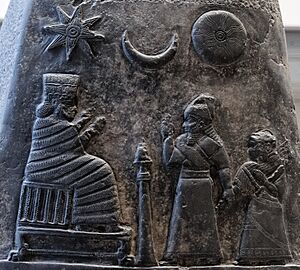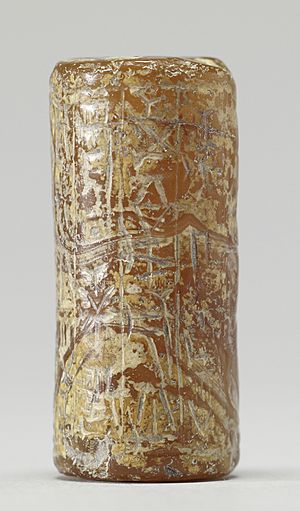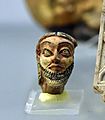Kassites facts for kids
Quick facts for kids
Kassite Empire
|
|||||||||||||
|---|---|---|---|---|---|---|---|---|---|---|---|---|---|
| c. 1531 BC – c. 1155 BC | |||||||||||||
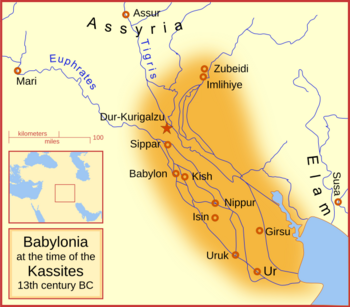
The Babylonian Empire under the Kassites, c. 13th century BC.
|
|||||||||||||
| Capital | Dur-Kurigalzu | ||||||||||||
| Common languages | Kassite, Akkadian | ||||||||||||
| Government | Monarchy | ||||||||||||
| King | |||||||||||||
|
• c. 1531 BC
|
Agum II (first) | ||||||||||||
|
• c. 1157—1155 BC
|
Enlil-nadin-ahi (last) | ||||||||||||
| Historical era | Bronze Age | ||||||||||||
|
• Established
|
c. 1531 BC | ||||||||||||
| c. 1531 BC | |||||||||||||
|
• Invasions by Elam
|
c. 1155 BC | ||||||||||||
|
• Disestablished
|
c. 1155 BC | ||||||||||||
|
|||||||||||||
| Today part of | Iraq, Iran, Kuwait | ||||||||||||
The Kassites (/ˈkæsaɪts/) were an ancient people who ruled Babylonia, a powerful kingdom in the ancient Near East. They took control around 1531 BC and their rule lasted until about 1155 BC. This period is known as the Kassite dynasty.
The Kassites gained power after the Hittites attacked and sacked the city of Babylon in 1531 BC. After this event, the Kassites established their own rule. At first, their capital was likely Babylon, but later they moved it to a new city called Dur-Kurigalzu. The Kassites had been present in the region for about 150 years before they took over Babylon. They sometimes worked with Babylon and sometimes against it. Records show that Kassite soldiers were hired by Babylonian kings like Samsu-iluna and Ammi-Ditana.
The Kassite language is still a mystery to experts. We don't know for sure where it came from or if it's related to other languages. The Kassite religion is also not well understood. We know the names of some of their gods, like Shuqamuna and Shumaliya, who were very important. When the Kassites ruled Babylon, they also started to worship Marduk, the city-god of Babylon.
Contents
History of the Kassites
Most of what we know about the Kassite period comes from thousands of clay tablets found in the ancient city of Nippur. These tablets include many different types of writings, such as:
- Records of daily life and laws
- Letters between people
- Inscriptions on seals
- Special writings for religious purposes
- Even parts of a historical story
Many of these tablets have not yet been fully studied. About 100 Kassite tablets were also found in Dur-Kurigalzu. Some building materials with writing from King Kurigalzu I were found in Kish. A few tablets from the time of King Agum III were discovered at a place called Qal'at al-Bahrain in Dilmun.
In total, about 12,000 Kassite documents have been found, but only about 10% have been published. There are also many inscriptions on buildings, mostly written in Sumerian, even though the Kassites usually spoke Akkadian. Many seals have been found too. Another important source of information is called a Kudurru. These were stone slabs used to record land grants and other important agreements. This practice continued even after the Kassite dynasty ended.
The ancient city of Nippur was very important to the Kassites. They repaired and built many religious and administrative buildings there. Major construction happened under kings like Kadashman-Enlil and Kudur-Enlil. Other important cities during the Kassite period included Larsa, Sippar, and Susa. The Kassites were also very active in Ur. At the site of Isin, which had been empty for a long time, the Kassites rebuilt the religious area, including the temple of the goddess Gula. This work was started by Kurigalzu I and continued by other kings. Even after the Kassite dynasty ended in 1155 BC, the way the country was run continued, and the land remained united.
Where Did the Kassites Come From?
The exact origin of the Kassites is not certain. Some Kassite names appear in old documents from the Third Dynasty of Ur (around 2112–2004 BC) in southern Babylon. Many historians believe they came from the Zagros Mountains. The Kassites were first mentioned in Babylonia in the 18th century BC, especially near the city of Sippar. For example, in the 9th year of King Samsu-iluna of Babylon, it was recorded that he defeated the Kassite army.
Kassites in the Bronze Age
As the Babylonian empire became weaker, the Kassites became a regular part of the region. Sometimes, they even provided soldiers for Babylon. The Hittites had taken the statue of the god Marduk from Babylon. But the Kassite rulers got Marduk back and returned him to Babylon. They made Marduk as important as their own god, Shuqamuna. Under Kassite rule, Babylon, which they renamed Karanduniash, became a strong political and military power again in Mesopotamia.

The fall of the First Sealand dynasty in 1460 BC created a power gap that the Kassites quickly filled. After the Mittani kingdom was destroyed by the Hittites in the early 14th century BC, Assyria grew stronger. This created a balance of power between the Kassites, Hittites, and Assyrians. Elam influenced the region from the east, and Egypt from the south. Many of the Amarna Letters are messages between these rulers, including 14 letters between the Pharaoh and the Kassite king. These kingdoms had a system of trade, treaties, and even marriages between their royal families. For example, there was a treaty between the Kassite ruler Karaindash and the Assyrian ruler Ashur-bel-nisheshu around 1410 BC.
At their strongest, the Kassites, led by Kurigalzu I in the mid-14th century BC, conquered Elam and attacked its capital, Susa. This king also started many important building projects in Ur and other cities in southern Mesopotamia. His most famous project was building a new city called Dur-Kurigalzu. This city had palaces and temples for many Babylonian gods. The Kassites also expanded their power into the Persian Gulf, reaching places like Qal'at al-Bahrain. Because they were close neighbors, the Assyrians and Kassites often fought each other for centuries.
The End of Kassite Rule
The Elamites, led by the Shutrukid dynasty, conquered Babylonia in the 12th century BC. They took away the Statue of Marduk, which marked the end of the Kassite state. According to some historical records, the last Kassite king, Enlil-nadin-ahi, was taken to Susa and imprisoned there in 1155 BC, where he died.
Later, in 702 BC, the Assyrian king Sennacherib wrote about his campaign against the land of the Kassites. This area was along the Diyala River. The Kassites tried to hide in the mountains, but they were captured and moved to other areas, which was a common practice for the Assyrians.
Kassite Kings
Old lists of Babylonian and Assyrian kings mention eight or nine early Kassite rulers whose names are not fully known. These kings ruled before the ones listed below. Another Kassite king, Hašmar-galšu, is known from five inscriptions found near Nippur.
| Ruler | Reign (short chronology) |
Comments | |
|---|---|---|---|
| Agum-Kakrime | Returned the Marduk statue to Babylon | ||
| Burnaburiash I | c. 1500 BC | Signed a treaty with Puzur-Ashur III of Assyria | |
| Kashtiliash III | Son of Burnaburiash I | ||
| Ulamburiash | c. 1480 BC | Conquered the first Sealand Dynasty | |
| Agum III | c. 1470 BC | May have fought in "The Sealand" and "in Dilmun" | |
| Karaindash | c. 1410 BC | Signed a treaty with Ashur-bel-nisheshu of Assyria | |
| Kadashman-harbe I | c. 1400 BC | Fought against the Suteans | |
| Kurigalzu I | c. x–1375 BC | Founded Dur-Kurigalzu and lived at the same time as Thutmose IV | |
| Kadashman-Enlil I | c. 1374–1360 BC | Lived at the same time as Amenophis III of Egypt (mentioned in the Amarna letters) | |
| Burnaburiash II | c. 1359–1333 BC | Lived at the same time as Akhenaten and Ashur-uballit I | |
| Kara-hardash | c. 1333 BC | Grandson of Ashur-uballit I of Assyria | |
| Nazi-Bugash | c. 1333 BC | A ruler who took power illegally | |
| Kurigalzu II | c. 1332–1308 BC | Son of Burnaburiash II, fought the Battle of Sugagi with Enlil-nirari of Assyria | |
| Nazi-Maruttash | c. 1307–1282 BC | Lived at the same time as Adad-nirari I of Assyria | |
| Kadashman-Turgu | c. 1281–1264 BC | Lived at the same time as Hattusili III of the Hittites | |
| Kadashman-Enlil II | c. 1263–1255 BC | Lived at the same time as Hattusili III of the Hittites | |
| Kudur-Enlil | c. 1254–1246 BC | A time when Nippur was rebuilt | |
| Shagarakti-Shuriash | c. 1245–1233 BC | Not the son of Kudur-Enlil, according to Tukulti-Ninurta I of Assyria | |
| Kashtiliashu IV | c. 1232–1225 BC | Removed from power by Tukulti-Ninurta I of Assyria | |
| Enlil-nadin-shumi | c. 1224 BC | Removed from power by Elamite king Kidin-Hutran III | |
| Kadashman-Harbe II | c. 1223 BC | ||
| Adad-shuma-iddina | c. 1222–1217 BC | Son of Kashtiliashu IV | |
| Adad-shuma-usur | c. 1216–1187 BC | Sent a strong letter to the kings of Assyria | |
| Meli-Shipak II | c. 1186–1172 BC | Exchanged letters with Ninurta-apal-Ekur | |
| Marduk-apla-iddina I | c. 1171–1159 BC | Son of Meli-Shipak II | |
| Zababa-shuma-iddin | c. 1158 BC | Defeated by Shutruk-Nahhunte of Elam | |
| Enlil-nadin-ahi | c. 1157–1155 BC | Defeated by Kutir-Nahhunte II of Elam |
Kassite Language
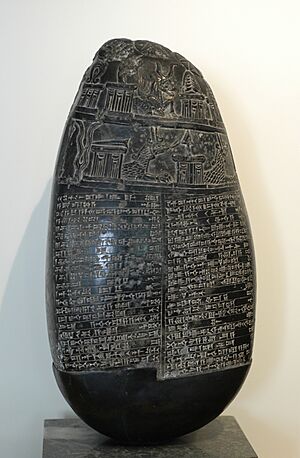
The Kassite language is a mystery. Experts have not been able to connect it to any other known language family. The only things we know about it come from:
- Personal names
- A few documents
- Some words related to horses and chariots
It is thought that Kassite was a language isolate, meaning it was not related to other languages like Indo-European or Semitic. Some linguists have suggested it might be linked to the Hurro-Urartian languages from the Armenian highlands.
Some historians believe that a few Kassite leaders had Indo-European names. This might mean that some of their ruling class came from Indo-European groups, similar to the Mitanni. However, over hundreds of years, the Kassites became part of the Babylonian population. Many of the later Kassite kings had Akkadian names, which was the language of Babylonia.
Kassite Art and Craftsmanship
Pottery and Ceramics
The Kassites made a lot of pottery. Their pottery has been found in many cities in Mesopotamia, including Eridu and Tell Khaiber. Archaeologists divide Kassite pottery into three time periods:
- Early Kassite (before about 1415 BC)
- Middle Kassite (about 1415–1225 BC)
- Late Kassite (about 1225–1155 BC)
Many small pottery ovens, usually less than 2 meters wide, were found in the Babylonian city of Dilbat. Common pottery items included goblets and bowls with wavy sides. Other ceramic items, like traps for small animals and stands for fruit, were also found. Kassite pottery has even been discovered as far away as Al Khor Island in the Persian Gulf.
Glass Works
Pieces of two Kassite glass cups were found during an excavation in 1964. These cups were found in a layer of destruction from around 800 BC in Hasanlu, northwest Iran. The cups were made of mosaic glass and were likely very old family treasures, possibly used for religious ceremonies. The glass pieces used to make these cups were very brightly colored, including bright green, blue, white, and red-orange. A Kassite text found at Dur-Kurigalzu mentions glass being given to artists to decorate the palace. Similar glass from 1500 BC was found at Tell al-Rimah.
Seal Impressions
Seals were widely used across the ancient Near East during the Kassite rule. They were used to mark official items and show who owned something. Each seal had a unique image, but many shared similar themes. Common images included:
- Bearded men
- Religious symbols
- Animals with horns
- Different types of plants and animals
These seals were usually made from stone, glass, or clay. The images were created by pressing or rolling the seals into wet clay.
Gallery
-
A winged centaur hunting animals, from the Kassite period. Now in the Louvre Museum.
See also
 In Spanish: Casitas para niños
In Spanish: Casitas para niños
- Chronology of the ancient Near East
- List of Mesopotamian dynasties
- Cities of the ancient Near East
- Early Kassite rulers
- Kassite deities
- Kassite language
- Kudurru




